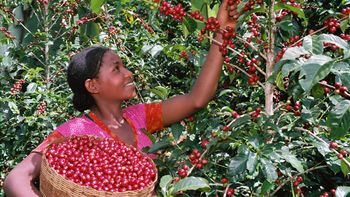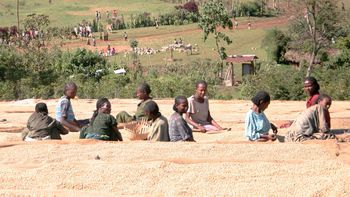Difference between revisions of "Improving Coffee Production and Quality Using Infrared Technology"
***** (***** | *****) |
***** (***** | *****) m |
||
| Line 1: | Line 1: | ||
| + | = Overview = | ||
| − | + | {| style="width: 100%" border="1" cellspacing="0" cellpadding="0" | |
| − | |||
| − | {| style="width: | ||
|- | |- | ||
| − | | style="width: | + | | style="width: 25%" | |
Project | Project | ||
| − | | style="width: | + | | style="width: 50%" | |
[http://poweringag.org/innovators/improving-coffee-production-quality-using-infrared-technology Improving Coffee Production and Quality Using Infrared Technology]<br/> | [http://poweringag.org/innovators/improving-coffee-production-quality-using-infrared-technology Improving Coffee Production and Quality Using Infrared Technology]<br/> | ||
| − | | | + | | rowspan="4" | |
| − | |||
[[File:HoAREC-Logo.jpg|center|200px|alt=HoAREC-Logo.jpg]]<br/> | [[File:HoAREC-Logo.jpg|center|200px|alt=HoAREC-Logo.jpg]]<br/> | ||
|- | |- | ||
| − | | style="width: | + | | style="width: 25%" | |
Collaborators | Collaborators | ||
| − | | style="width: | + | | style="width: 50%" | |
[https://www.uni-hohenheim.de/english University of Hohenheim] (Germany)<br/> | [https://www.uni-hohenheim.de/english University of Hohenheim] (Germany)<br/> | ||
| Line 27: | Line 25: | ||
|- | |- | ||
| − | | style="width: | + | | style="width: 25%" | |
Location Applied | Location Applied | ||
| − | | style="width: | + | | style="width: 50%" | |
[[Ethiopia Energy Situation|Ethiopia]]<br/> | [[Ethiopia Energy Situation|Ethiopia]]<br/> | ||
|- | |- | ||
| − | | style="width: | + | | style="width: 25%" | |
Website | Website | ||
| − | | style="width: | + | | style="width: 50%" | |
[http://www.hoarec.org/index.php/en/ Horn of Africa]<br/> | [http://www.hoarec.org/index.php/en/ Horn of Africa]<br/> | ||
|} | |} | ||
| − | + | Coffee accounts for 60 percent of the export earnings in [[Ethiopia Energy Situation|Ethiopia]], and is processed by dry and wet processing. Wet processed is preferred in the global market. Unfortunately, farmers do not see the full benefit of their coffee production. A significant portion of coffee harvested is of inferior quality due to the traditional sun drying process. This process can take up to twelve days and increases exposure of coffee to fungi and other undesirable elements. Thermal drying is energy intensive and takes up a large amount of space.<ref name="Powering Agriculture: http://poweringag.org/innovators/improving-coffee-production-quality-using-infrared-technology">Powering Agriculture: http://poweringag.org/innovators/improving-coffee-production-quality-using-infrared-technology</ref> | |
| − | |||
| − | Coffee accounts for 60 percent of the export earnings in [[Ethiopia Energy Situation|Ethiopia]], and is processed by dry and wet processing. Wet processed is preferred in the global market. Unfortunately, farmers do not see the full benefit of their coffee production. A significant portion of coffee harvested is of inferior quality due to the traditional sun drying process. This process can take up to twelve days and increases exposure of coffee to fungi and other undesirable elements. Thermal drying is energy intensive and takes up a large amount of space.<ref name="Powering Agriculture: http://poweringag.org/innovators/improving-coffee-production-quality-using-infrared-technology">Powering Agriculture: http://poweringag.org/innovators/improving-coffee-production-quality-using-infrared-technology</ref | ||
| − | |||
| − | |||
| − | = Clean Energy Solution | + | = Clean Energy Solution = |
The proposed solution uses state of the art infrared technology to reduce coffee pulp drying time from several days to hours. Reduced drying time minimizes the post-harvest loss that occurs when using the conventional sun drying process. [[Biogas Basics|Biogas]] generated from coffee pulp and coffee husk will be used to power the bioreactors used for infrared drying.<ref name="Powering Agriculture: http://poweringag.org/innovators/improving-coffee-production-quality-using-infrared-technology">Powering Agriculture: http://poweringag.org/innovators/improving-coffee-production-quality-using-infrared-technology</ref><br/> | The proposed solution uses state of the art infrared technology to reduce coffee pulp drying time from several days to hours. Reduced drying time minimizes the post-harvest loss that occurs when using the conventional sun drying process. [[Biogas Basics|Biogas]] generated from coffee pulp and coffee husk will be used to power the bioreactors used for infrared drying.<ref name="Powering Agriculture: http://poweringag.org/innovators/improving-coffee-production-quality-using-infrared-technology">Powering Agriculture: http://poweringag.org/innovators/improving-coffee-production-quality-using-infrared-technology</ref><br/> | ||
<p style="text-align: center;">{{#widget:YouTube|id=lK8YcmC3QqI|height=400|width=800}}<br/></p> | <p style="text-align: center;">{{#widget:YouTube|id=lK8YcmC3QqI|height=400|width=800}}<br/></p> | ||
| − | |||
| − | |||
| − | |||
| − | + | = Impact = | |
| − | + | The project will significantly reduce the time farmers spend processing their crop. This time saved can be used for other more productive activities. Converting waste products from coffee production into useful energy reduces greenhouse gas emissions. The project will also improve work conditions for women and children, who are primarily responsible for the sun drying process which requires all-day exposure to the sun. In addition, the project will provide alternative livelihoods for the woman by engaging them in mushroom production from coffee husk.<ref name="Powering Agriculture: http://poweringag.org/innovators/improving-coffee-production-quality-using-infrared-technology">Powering Agriculture: http://poweringag.org/innovators/improving-coffee-production-quality-using-infrared-technology</ref> | |
| − | + | [[File:Red-cherry-picking-by-Borena-Girl.jpg|thumb|left|350px|Red Cherry Picking © Powering Agriculture|alt=Red Cherry Picking (c) Powering Agriculture]][[File:Coffee Crop Farmers.jpg|thumb|right|350px|Coffee Crop Farmers © Powering Agriculture|alt=Coffee Crop Farmers (c) Powering Agriculture]] | |
| − | = Organization | + | = Organization = |
| − | The Horn of Africa Regional Environment Center and Network (HoA-REC&N) is an autonomous institution under Addis Ababa University. HoA-REC&N focuses on environmental concerns and sustainable development options within the Horn of Africa. Partner institutions include University of Hohenheim; University of Massachusetts–Boston; and the Oromia Coffee Farmers Cooperative Union.<ref name="Powering Agriculture: http://poweringag.org/innovators/improving-coffee-production-quality-using-infrared-technology">Powering Agriculture: http://poweringag.org/innovators/improving-coffee-production-quality-using-infrared-technology</ref | + | The Horn of Africa Regional Environment Center and Network (HoA-REC&N) is an autonomous institution under Addis Ababa University. HoA-REC&N focuses on environmental concerns and sustainable development options within the Horn of Africa. Partner institutions include University of Hohenheim; University of Massachusetts–Boston; and the Oromia Coffee Farmers Cooperative Union.<ref name="Powering Agriculture: http://poweringag.org/innovators/improving-coffee-production-quality-using-infrared-technology">Powering Agriculture: http://poweringag.org/innovators/improving-coffee-production-quality-using-infrared-technology</ref> |
| − | + | = Further Information = | |
| − | |||
| − | = Further Information | ||
*[[Ethiopia Energy Situation|Ethiopia Energy Situation]]<br/> | *[[Ethiopia Energy Situation|Ethiopia Energy Situation]]<br/> | ||
| Line 76: | Line 65: | ||
*Website [http://www.oromiacoffeeunion.org/ Oromia Coffee Farmers Cooperative]<br/> | *Website [http://www.oromiacoffeeunion.org/ Oromia Coffee Farmers Cooperative]<br/> | ||
| − | + | = References = | |
| − | |||
| − | = References | ||
| − | <references /> | + | <references/> |
[[Category:Powering_Agriculture]] | [[Category:Powering_Agriculture]] | ||
Revision as of 14:33, 10 May 2016
Overview
|
Project |
Improving Coffee Production and Quality Using Infrared Technology |
|
|
Collaborators |
University of Hohenheim (Germany) University of Massachusetts Boston (United States) Oromia Coffee Farmers Cooperative Union (Ethiopia) | |
|
Location Applied |
||
|
Website |
Coffee accounts for 60 percent of the export earnings in Ethiopia, and is processed by dry and wet processing. Wet processed is preferred in the global market. Unfortunately, farmers do not see the full benefit of their coffee production. A significant portion of coffee harvested is of inferior quality due to the traditional sun drying process. This process can take up to twelve days and increases exposure of coffee to fungi and other undesirable elements. Thermal drying is energy intensive and takes up a large amount of space.[1]
Clean Energy Solution
The proposed solution uses state of the art infrared technology to reduce coffee pulp drying time from several days to hours. Reduced drying time minimizes the post-harvest loss that occurs when using the conventional sun drying process. Biogas generated from coffee pulp and coffee husk will be used to power the bioreactors used for infrared drying.[1]
Impact
The project will significantly reduce the time farmers spend processing their crop. This time saved can be used for other more productive activities. Converting waste products from coffee production into useful energy reduces greenhouse gas emissions. The project will also improve work conditions for women and children, who are primarily responsible for the sun drying process which requires all-day exposure to the sun. In addition, the project will provide alternative livelihoods for the woman by engaging them in mushroom production from coffee husk.[1]
Organization
The Horn of Africa Regional Environment Center and Network (HoA-REC&N) is an autonomous institution under Addis Ababa University. HoA-REC&N focuses on environmental concerns and sustainable development options within the Horn of Africa. Partner institutions include University of Hohenheim; University of Massachusetts–Boston; and the Oromia Coffee Farmers Cooperative Union.[1]
Further Information
- Ethiopia Energy Situation
- Website Powering Agriculture Homepage, Winners 2015
- Powering Agriculture: An Energy Grand Challenge for Development
- Website Horn of Africa
- Website Oromia Coffee Farmers Cooperative
References
- ↑ 1.0 1.1 1.2 1.3 Powering Agriculture: http://poweringag.org/innovators/improving-coffee-production-quality-using-infrared-technology






















